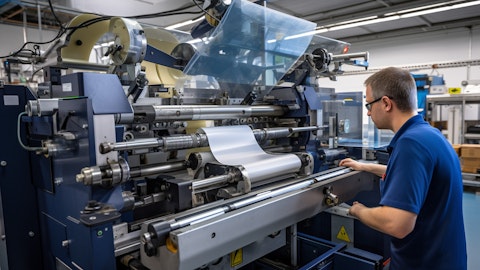VeriSign, Inc. (NASDAQ:VRSN) Q3 2025 Earnings Call Transcript October 23, 2025
VeriSign, Inc. misses on earnings expectations. Reported EPS is $2.27 EPS, expectations were $2.29.
Operator: Good day, everyone. Welcome to VeriSign’s Third Quarter 2025 Earnings Call. Today’s conference is being recorded. Recording of this call is not permitted unless preauthorized. At this time, I’d like to turn the conference over to Mr. David Atchley, Vice President of Investor Relations and Corporate Treasurer. Please go ahead, sir.
David Atchley: Thank you, operator. Welcome to VeriSign’s Third Quarter 2025 Earnings Call. Joining me are Jim Bidzos, Executive Chairman, President and CEO; and John Calys, Executive Vice President and CFO. This call and presentation are being webcast from the Investor Relations website, which is available under about VeriSign on verisign.com. There, you will also find our earnings release. At the end of this call, the presentation will be available on that site, and within a few hours, the replay of the call will be posted. Financial results in our earnings release are unaudited, and our remarks include forward-looking statements that are subject to the risks and uncertainties that we discuss in detail in our documents filed with the SEC, specifically the most recent reports on Form 10-K and 10-Q.
VeriSign does not update financial performance or guidance during the quarter unless it is done through a public disclosure. The financial results in today’s call and the matters we will be discussing today include GAAP results and 2 non-GAAP measures used by VeriSign, adjusted EBITDA and free cash flow. GAAP to non-GAAP reconciliation information is appended to the slide presentation, which can be found on the Investor Relations section of our website available after this call. Jim and John will now provide prepared remarks. And afterward, we will open the call for your questions. With that, I would like to turn the call over to Jim.
D. Bidzos: Thank you, David. Good afternoon to everyone, and thank you for joining us. VeriSign delivered both growth in a domain name base and solid financial performance during the third quarter. We also continued our consistent return of value to shareholders through dividends and share repurchases. At the end of September, the domain name base for .com and .net totaled 171.9 million domain names, up 1.4% year-over-year. We had strengthened the quarter with 10.6 million new registrations. Revenue was up 7.3% year-over-year and EPS is up 9.7% year-over-year. During the quarter, we returned $72 million through dividends and $215 million through share repurchases for a total return to shareholders of $287 million. The positive domain name base trends we saw during the first half of the year continued during the third quarter.
Net registrations added during the third quarter were 1.5 million names. This was made possible by the strong volume of new registrations already mentioned and improvement in the year-over-year preliminary renewal rate. The renewal rate for the third quarter of 2025 is expected to be 75.3% compared to 72.2% a year ago. The domain name base grew sequentially in our 3 main regions with the U.S. and EMEA being the strongest. We’re seeing solid underlying demand for our domain names and continued registrar engagement with our programs which together have enhanced the pace of growth in new registrations. Given these continued positive domain name base trends, we now expect the growth in the domain name base to be between 2.2% and 2.5% for 2025. Our financial and liquidity position remained stable with $618 million in cash, cash equivalents and marketable securities at the end of the quarter.

At the end of the quarter, $1.33 billion remained available under the current share repurchase program, which has no expiration. As announced in today’s earnings release, VeriSign’s Board of Directors declared a cash dividend of $0.77 per share of VeriSign’s outstanding common stock to stockholders of record as of the close of business on November 18, 2025, payable on November 25, 2025. VeriSign intends to continue to pay a cash dividend on a quarterly basis, subject to market conditions and approval by VeriSign’s Board of Directors. And now I’d like to turn the call over to John. I’ll return when John has completed his financial report with some closing remarks.
John Calys: Thank you, Jim, and good afternoon, everyone. For the quarter ended September 30, 2025, the company generated revenue of $419 million, up 7.3% from the same quarter a year ago. Operating expense in Q3 2025 totaled $135 million, which compares to $129 million last quarter and $121 million for the third quarter last year. The areas we saw increases include incentive compensation and legal costs. Net income in the third quarter totaled $213 million compared to $207 million last quarter and $201 million in the third quarter last year. Third quarter diluted earnings per share was $2.27 compared to $2.21 last quarter and $2.07 for the same quarter of 2024. Operating cash flow for the third quarter 2025 was $308 million and free cash flow was $303 million, compared with $253 million and $248 million, respectively, in the quarter a year ago.
I will now discuss our updated full year 2025 guidance. Revenue is expected to be between $1.652 billion and $1.657 billion. Operating income is now expected to be between $1.119 billion and $1.124 billion. Interest expense and nonoperating income net, which includes interest income estimates, is still expected to be an expense between $50 million and $60 million. Capital expenditures are still expected to be between $25 million and $35 million and the GAAP effective tax rate is still expected to be between 21% and 24%. In summary, VeriSign continued to demonstrate sound financial discipline during the quarter. Now I will turn the call back to Jim for his closing remarks.
D. Bidzos: Thank you, John. The improved domain name base trends that emerged at the end of 2024 continued through the first 3 quarters of 2025. We’re seeing strength in demand for our domain names, which we believe are the results of the plans and expectations we laid out last year. Our adjustments to our channel programs, along with anticipated favorable cyclical shifts from ARPU to customer acquisition. Of note is that these improved trends are seen across our main 3 regions with strength in the U.S. picking up during the third quarter. Our 2025 programs have deepened our engagement with our channel and we use their feedback to improve our 2026 programs, which we have rolled out to our registrars. We look forward to finishing out 2025 from a position of strength with these positive domain name base trends.
I would note that we also see increases in registration and resolution activity for which we believe increasing use of AI is the — is a primary driver. Thanks for your attention today. This concludes our prepared remarks, and now we’ll open the call for your questions. Operator, we’re ready for the first question.
Q&A Session
Follow Verisign Inc (NASDAQ:VRSN)
Follow Verisign Inc (NASDAQ:VRSN)
Receive real-time insider trading and news alerts
Operator: [Operator Instructions] And the first question comes from Rob Oliver with Baird.
Robert Oliver: A couple of questions from me. Jim, I guess, first, I appreciate all the color on the domain base trends that you’re seeing. I guess, going back to Q1 of last year, when you guys called out the changes you need to make in your marketing programs. We’ve seen a nice improvement in those domain-based trends from sort of beginning of this year through now. You cited a few reasons, but I was wondering if you can give us a little bit more color perhaps on how much of it is macro, how much of it is stuff that you guys are controlling with your marketing programs? Any other color you can provide in particular geos would be helpful. And then I had a couple of quick follow-ups.
D. Bidzos: Okay. Well, I think really, the story is pretty much the one that I talked about in my remarks. It’s just basically blocking and tackling in a sense. We improved our programs and made them more adaptable for our channel. We got great engagement from our channel. We’ve been talking about a cyclical shift that we were hoping for and anticipating and that came around. So that added to the growth. The registrar engagement with our marketing programs is also helping us sharpen our 2026 programs. I guess some more details we can share. John, do you want to?
John Calys: Sure. Thanks, Jim. As Jim mentioned, we saw good strength across all of our 3 main regions. EMEA has been the most consistent region over the past few quarters. But what we saw in third quarter was the U.S. improved very nicely and was strong during the quarter. The domain base in Asia Pac, which includes China, did grow again, but it wasn’t as strong as the growth we saw during the first half of 2025. Our programs seem to be contributing to the improving trend of domain — of demand for our domain names. We saw a success with our marketing efforts during 2025. We’ve already rolled out our programs to registrars for 2026. As Jim mentioned, we continue to incorporate feedback from our registrars and have further refined our approach for 2026.
As you would expect, we’ll continue to invest in programs that have been working well, and the initial response from our registrars to the 2026 programs has been positive. Just as a reminder, the cost of our marketing programs is included in our updated guidance we provide today, and all of these programs are accretive. In addition to the strong volume in new registrations, the renewal rate has continued to improve as evidenced by the preliminary renewal rate in third quarter of 75.3%, that’s up from 72.2% a year ago, both the first time and previously renewed rates have improved year-over-year. And as a reminder, the overall renewal rate is impacted by the mix of first-time renewing names this year versus last. And more specifically, last year, we had fewer new registrations which means fewer first-time renewals this year, which tends to improve the overall renewal rates.
The midpoint of our improved DNB guidance for 2025 reflects a continuation of the trends seen in the first 3 quarters of the year, and we plan to provide you with 2026 guidance during our February call after we have a chance to see how domain-based trends finish out ’25 and start out 2026. To sum it up, we’re pleased with the improvements in both growth and renewal rates and that these better trends are seen across our main regions.
Robert Oliver: That’s really helpful. Okay, thanks John, appreciate it. Jim, I want to ask specifically about changes that Google has made this year to their AdSense program and what, if any, impact you might be seeing or expect to see within your current domain base from those changes?
D. Bidzos: Okay. Well, this — so Google’s AdSense has been around for a long time and the changes that they made are part of a long process that’s not new. Through the almost 15 years, they started in 2011, 15 years, Google has been making changes to their algorithm, and they’ve steadily eroded domain names that exist solely for ad monetization with AdSense. So changes this year to AdSense have continued a multiyear predictable strategy from Google to reduce their reliance of both advertisers and domain name registrants on that particular service. So this isn’t a new trend. And after a decade of these changes, we view our exposure as minimal. Don’t confuse these domain names with names that have been purchased for resale. Some of these are parked because it doesn’t cost anything to do so, but the intent of these domains and the value of these domain names is for resale are not impacted by changes to AdSense.
Robert Oliver: Yes. Yes, that helps. Okay. If I have time for one more, I’ll just — I’ll ask one more. Just wondering if I can hear from you, Jim, just a broader sense of your view on how you see AI potentially impacting your business, how you see it impacting your business at all today and how you think it might impact your business going forward? I know you guys have said that any technology that makes it easier to create and use domains is good for you guys. I think that’s generally true, and we’re seeing a lot of activity in that regard. But would love to hear your view on — from a high-level perspective on AI.
D. Bidzos: Thanks — yes. Thanks for that question. AI is on everybody’s mind these days, and it’s no surprise, we get a lot of questions about it. So let me answer that in 2 parts. One, what impact we’re seeing in our business and separately how we’re using ourselves to manage our business. So on the first part, it’s early, but with the data we have this year, it’s clear to us that AI is having a positive impact on registrations as well as on the utilization of our DNS resolution services. I might mention today, our infrastructure on average, processes over 450 billion DNS transactions per day and growing. Just 2 years ago, that number was $200 billion per day. So AI companies need data, and they’re continuously scouring the Internet to get it.
Data is not static. And so AIs like search engines are constantly fetching fresh data from websites to augment their existing data. This is enabled by the DNS. There’s no doubt in our minds that this trend will continue growing importance and will be additive to the existing drivers of DNS Reliance. So we think this applies even more to the agentic web. Agentic AI can do more for you, you set an objective, and the AI can plan steps and execute required tasks. So for example, the launch of Agentic browsers is making interaction with websites more user-friendly, even more powerful. It lets users summarize information across multiple open tabs, from any websites, applications and Internet services. Again, this is enabled by the DNS. Also, AI can be powerful for domain name suggestions, website provisioning and content generation.
So we’ve used and continue to use AI in our domain name suggestion platforms. For example, AI is enabling more sophisticated multi keyword name suggestions based upon natural language across many languages. And of course, like most businesses, we look for ways AI can provide efficiencies and better protect our services. And one last thing. Looking ahead, we believe domain names will remain critical in providing many important services. They can serve as digital trust anchors, providing trust and authenticity of a destination, critical for Agentic AI. Domain names provide globally unique, stable, human-readable identifiers for verifying digital content and can be especially valuable in combating misinformation and deepfakes hypercritical for AI.
As it relates to infrastructure for new protocols because AI agents autonomously crawl the Internet to complete complex tasks, we believe demand for persistent, resolvable identities and endpoints will continue. But the traditional use of domain names isn’t going away. Businesses require branding, discoverability and credibility. So domain names and recognized and trusted high assurance TLDs like .com and net hold strong value. Registrars in the DNS ecosystem are well positioned to layer new value-added services on this infrastructure, again, all enabled by the DNS. So from what we see today, the trends are very positive.
Operator: And we’ll take our last question from Ygal Arounian with Citi.
Ygal Arounian: I guess I want to follow up on some of Rob’s questions. Maybe first, just on the marketing programs. And there’s been a lot of questions on this lately from investors. And maybe if you could help just kind of parse through marketing programs, what’s worked in particular. And if there’s been a lot of discounting within that? Or is that just the cadence and pace of discounting has changed at all? And just note in your — in the SG&A line, there was a sort of a notable step up there. I think you called out some legal expenses. But if you strip those out, that sort of more normalized, you step up a little bit in that spending? Maybe just kind of help us think through that a little bit more.
John Calys: Yes, Ygal. This is John. We do think our marketing programs have contributed to the growth we’ve seen in 2025. I would point out that from a cost standpoint, those programs are accounted for as a reduction in revenue. So in the SG&A, there really isn’t a significant change in marketing dollars in that line item. So it really is the incentive comp and the legal costs that I mentioned during my prepared remarks. That said, we’ve seen — we’ve tried to shift our programs towards ones that yield higher quality and higher renewing names. And we think those are working at least to date. We’ve made some adjustments to those programs for 2026. The initial response that we’ve gotten from registrars as we begin to roll out those new offerings to them has been very positive.
And so we’re pleased with that. We continuously review our programs, monitor their performance and listen to feedback for registrars, and we will continue to invest in programs that we see are successful. The last thing I would say is don’t think of our programs of something that’s finite for 2025 or finite for 2026. Think of these programs as an evolution of what we’ve run for several years. And the main thing we’ve changed recently as we give more choices to be responsive to the changing market. So you can expect us to continue to learn, adapt and where appropriate, implement changes to our programs going forward.
Ygal Arounian: Okay. And so another follow-up on the Google AdSense issue. Just — I think there’s a lot of opaqueness in this industry and maybe things that investors don’t understand. Jim, you mentioned a lot of park domains are deferred kind of resale, a lot of the park domains are there for defensive purposes. Like is there any way to sort of break out what you think the split is on advertising monetized or aftermarket monetized defensive? And I think there were a number of players in the — or a couple of players, key players, public players in the market that saw some impact from this in particular, which might be where some of this fear has been spreading from. So it does feel like it’s impacting somewhere. If you could just comment on that and your thoughts on that.
D. Bidzos: Sure. When you say it’s impacting somewhere, meaning not in our zone, you’re not talking about that. I want to make sure I understand the question.
Ygal Arounian: I’m talking about like some public players that have seen an impact to add revenue from this change on advertising on park domains.
D. Bidzos: Well, if that’s your revenue model to make — to earn revenue from monetizing traffic in parked domains through AdSense, yes, you’ve been on a downhill slide for 15 years. It was a 2011, I think many of those listening may remember this, Google introduced a change to their search algorithm called Panda, and then they did some more. There was Penguin and I think some others that started with P. And I remember during earnings calls, we’d go through each one and what impact it would have. And that’s what I meant when I said that, that particular business has been eroding for 15 years. What I meant about the other side of the business or the other side of those domains is that the domains that are purchased for resale can be easily parked.
In fact, I actually found that a registrar had parked a domain that I owned that I wasn’t doing anything with, because I guess I didn’t check the box that said don’t park my domain. So they can pick up a small amount of revenue or at least they could. This happened about 9 years ago. So I think those domains are purchased for resale. They are — those are — you can see those for sale. And on registrars, almost every major registrar now has an aftermarket available for premium com domains. Those are different, but you may — some of those could be part is the point I was making. So I don’t have a segment breakout in detail. We do some analysis, but we don’t disclose that.
John Calys: Okay. And then finally, just shifting to different. Just an update on — if there is any on .web time line or expectations and maybe in particular, like if sort of loophole on this process continuing open over again, might change? And then maybe with — at the same time, just if you could talk about any update on how you think about the new — I guess it’s not really an auction model anymore, but with new TLDs and how that might play out later next year and into 2027?
D. Bidzos: Okay. So first of all .web, there’s nothing substantive that’s new since we talked last quarter. The — but what is true is that what I reported then, which is that the final hearing is still scheduled for mid-November 2025. So I think there’s anybody new on the call, just to reiterate, we intend to become the registry operator for .web. We hope to bring it as soon as we can to our customers. We believe Altanovo, who in this legal proceedings believe their use of ICANNs processes to keep that from happening as an abusive process and is being pursued in bad faith to keep web off the market. So we only have weeks now until at least that process begins, and we’ll certainly keep you informed when we can about anything that comes out of that. I’m sorry, you had kind of a second part of that?
Ygal Arounian: Yes, just on the upcoming domain auctions and — on that process yes, for later next year and into, I think, 2027?
D. Bidzos: ICANN 2026 round of new gTLDs you’re referring to. Yes. Yes, that’s — I believe that’s on target to open the round in the second quarter, I believe, is ICANNs goal to do that. Unlike the 2013 round, there will not be auctions. There will be a different process that they use, but they haven’t started rolling all that out yet. I think like a lot of companies, we are looking at any opportunities there. If there’s something that we’re interested in, we have our teams studying that, nothing to report yet. But yes, that round, if everything runs on schedule, I’m not sure exactly what the timing for the process is after the opening of the round and the submission of applications and there’s a lot of process that goes with these. So I can’t tell you exactly when. But yes, I think, 2027, you’ll probably — is probably the earliest that they’ll actually be deployed because of the process. But it starts Q2 2026 according to ICANN.
Operator: And that does conclude the question-and-answer session. I’ll now turn the conference back over to Mr. David Atchley.
David Atchley: Thank you, operator. Please call the Investor Relations department with any follow-up questions from this call. Thank you for your participation. This concludes our call. Have a good evening.
Operator: Thank you. That does conclude today’s conference. We do thank you for your participation. Have an excellent day.
Follow Verisign Inc (NASDAQ:VRSN)
Follow Verisign Inc (NASDAQ:VRSN)
Receive real-time insider trading and news alerts




